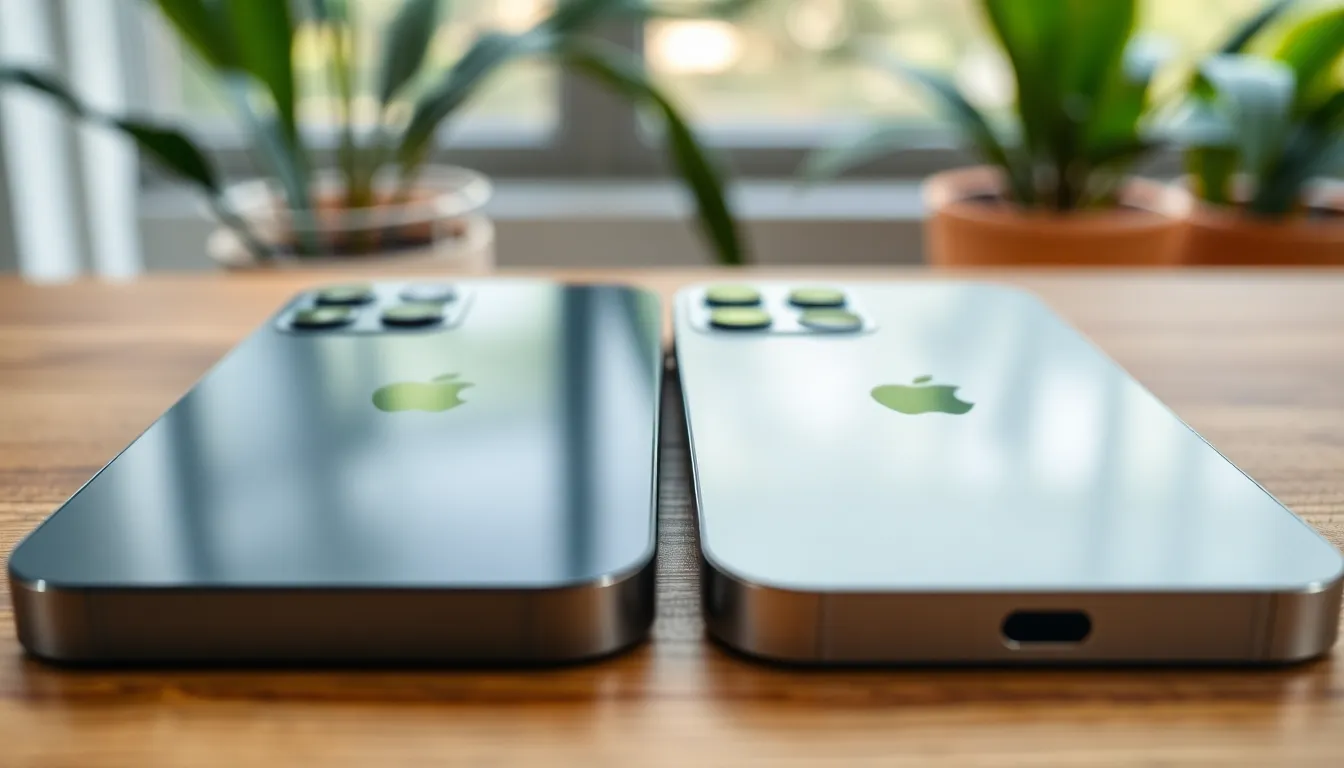When it comes to smartphones, the battle between the iPhone 13 and iPhone 14 is hotter than a freshly brewed cup of coffee. Apple fans everywhere are scratching their heads, wondering if the shiny new features of the iPhone 14 really make it worth the upgrade or if the trusty iPhone 13 still reigns supreme. After all, why fix what isn’t broken?
Table of Contents
ToggleOverview of iPhone 13 and iPhone 14
The iPhone 13 and iPhone 14 both feature impressive technology and design elements. Users find themselves debating whether the differences justify an upgrade.
Key Features Comparison
The iPhone 13 boasts an A15 Bionic chip and a dual-camera system. The iPhone 14 includes enhancements like improved low-light photography and emergency SOS via satellite. Battery life remains strong for both models, with iPhone 13 lasting up to 19 hours and iPhone 14 offering similar longevity. Storage options vary, with iPhone 13 starting at 128 GB and iPhone 14 offering up to 512 GB. Display brightness also increases slightly, with iPhone 14 achieving up to 2000 nits of peak brightness compared to iPhone 13’s 1200 nits. These features contribute to different user experiences.
Design and Build Quality
Both models utilize premium materials, including glass and aluminum. A notable difference lies in weight, with the iPhone 14 being slightly heavier due to added components. Color options differ, with iPhone 13 offering six shades and iPhone 14 introducing new hues for custom aesthetics. Dimensions remain similar, though the iPhone 14 shows subtle adjustments in thickness. IP68 water resistance rating applies to both, providing peace of mind for users. Overall, both phones maintain elegant designs characterized by rounded edges and flat surfaces.
Performance Analysis

The performance of the iPhone 13 and iPhone 14 showcases significant advancements in technology. Comparative analysis reveals key differences between the two models.
Processor and Speed
Both iPhones utilize the A15 Bionic chip, ensuring high processing capabilities. The iPhone 14 benefits from optimizations that enhance its speed, especially during demanding tasks like gaming or video editing. Increased performance in the iPhone 14 translates to quicker app launches and smoother multitasking. Apple’s improvements extend to machine learning tasks, where the iPhone 14 demonstrates superior efficiency compared to its predecessor. Speed benchmarks show a noticeable edge for the iPhone 14, making it a stronger candidate for power users.
Battery Life
Battery performance serves as a crucial consideration for many users. Although both models boast similar longevity, the iPhone 14 features slight enhancements in power management. Users can expect up to 20 hours of video playback on the iPhone 14, surpassing the 19 hours offered by the iPhone 13. Generally, both phones experience excellent battery life during typical usage, but the iPhone 14’s improved power efficiency becomes evident during intensive tasks. Enhanced battery longevity may influence users who prioritize extended usage throughout the day.
Camera Capabilities
Camera capabilities play a crucial role in deciding between the iPhone 13 and iPhone 14. Both models deliver impressive photography experiences, but key differences exist.
Photography Features
The iPhone 13 features a dual-camera system with 12MP wide and ultra-wide lenses, enabling users to capture vibrant images in various lighting conditions. In contrast, the iPhone 14 introduces larger sensors that enhance low-light performance significantly. Both models support Night mode, but the iPhone 14 also includes advanced computational photography capabilities, such as Photonic Engine. This development improves color and detail in darker environments. Photographers benefit from Smart HDR 4 on the iPhone 14, which elevates dynamic range. Users seeking superior results in challenging lighting conditions may favor the iPhone 14.
Video Recording Quality
When it comes to video recording quality, the iPhone 13 offers impressive 4K capabilities at 60fps, making it suitable for most users. The iPhone 14 enhances this experience with improved stabilization through Action mode, providing smoother footage during motion-heavy scenes. With both models featuring Cinematic mode for depth-of-field effects, the iPhone 14 adds Dolby Vision HDR recording, achieving more vibrant color accuracy and enhanced contrast in videos. Users engaged in high-quality video production looking for cutting-edge features will likely prefer the iPhone 14.
User Experience
User experience remains a critical factor in comparing the iPhone 13 and iPhone 14. Both devices offer strong ecosystems, but subtle differences in features can influence user satisfaction.
Operating System and Software
Apple consistently updates its software to enhance user experience. Both iPhone 13 and iPhone 14 run on iOS, but the iPhone 14 recently received optimized features that enhance performance. Users can expect quicker updates and improved functionality with newer apps on the iPhone 14. Additionally, with integrated software enhancements, the iPhone 14 showcases advanced multitasking capabilities, allowing for smoother transitions between applications. This optimization strengthens the argument for those contemplating an upgrade.
Additional Features and Improvements
Features like emergency SOS via satellite on the iPhone 14 represent significant advancements in user safety. Enhanced low-light photography capabilities also entice photography enthusiasts. Users appreciate the brighter display on the iPhone 14, which reaches 2000 nits compared to the iPhone 13’s 1200 nits, making outdoor usage more comfortable. Additionally, improved battery efficiency allows extended use, with the iPhone 14 providing up to 20 hours of video playback. Users looking for cutting-edge performance and vibrant display will find these improvements compelling.
Pricing and Value
Pricing plays a crucial role in the decision to choose between the iPhone 13 and iPhone 14. Knowing their prices helps users understand the financial implications of their choice.
Cost Comparison
The iPhone 13 typically retails for around $699, making it an attractive option for budget-conscious consumers. In contrast, the iPhone 14 starts at approximately $799, reflecting its enhanced features and improvements. Price variations occur based on storage options, with both models offering storage selections of 128 GB, 256 GB, and 512 GB. Deals and discounts fluctuate over time, so potential buyers may find promotional offers that further influence their choices.
Which One Offers Better Value?
Better value depends on individual preferences and usage patterns. Users heavily engaged in photography or gaming might find the iPhone 14 justifies the higher price due to its advanced camera and performance enhancements. For those satisfied with solid functionality without needing the latest features, the iPhone 13 stands out as a smart choice. Longevity plays a role; the iPhone 14’s updated specifications may provide a more future-proof investment. When considering overall effectiveness, the context of use factors significantly into the value equation for consumers.
Choosing between the iPhone 13 and iPhone 14 ultimately hinges on individual needs and priorities. The iPhone 14 offers significant advancements in camera technology and performance that appeal to power users and photography enthusiasts. Its enhanced features like improved low-light capabilities and emergency SOS via satellite provide compelling reasons to upgrade.
On the other hand the iPhone 13 remains a solid choice for those seeking reliable performance without the latest bells and whistles. Its lower price point makes it an attractive option for budget-conscious consumers. Ultimately the decision should reflect personal usage patterns and preferences ensuring that users select the model that best aligns with their lifestyle.


